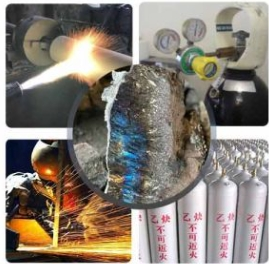
In the chemical industry, calcium carbide is a commonly used raw material. However, its reaction with water can pose significant safety risks. This article will delve into the risks associated with the reaction between calcium carbide and water, focusing on how to prevent acetylene explosion accidents and other safety hazards.
Calcium carbide (CaC₂) reacts with water (H₂O) to produce acetylene (C₂H₂) gas and calcium hydroxide (Ca(OH)₂). The chemical equation is: CaC₂ + 2H₂O → C₂H₂ + Ca(OH)₂. Acetylene is a highly flammable gas, and when it mixes with air in a certain proportion (2.5% - 82% by volume), it forms an explosive mixture. Any ignition source can trigger a violent explosion.

According to industry statistics, acetylene - related explosion accidents account for a significant proportion of chemical safety incidents. For example, in a certain chemical plant, due to improper storage of calcium carbide, it came into contact with water, resulting in a large amount of acetylene gas leakage. A small spark from an electrical device triggered a powerful explosion, causing serious damage to the plant and endangering the lives of workers.
Calcium carbide often contains impurities such as calcium phosphide (Ca₃P₂). When calcium carbide reacts with water, calcium phosphide also reacts to produce phosphine (PH₃), a highly toxic gas. Inhalation of phosphine can cause serious harm to the human body, including damage to the respiratory system, nervous system, and even death. In some real - world cases, workers were poisoned by phosphine during the operation of calcium carbide, highlighting the hidden danger of this impurity.
Before using calcium carbide, it is necessary to conduct a detailed analysis of its components. By accurately measuring the content of impurities such as calcium phosphide, appropriate safety measures can be taken. For example, if the content of calcium phosphide is relatively high, additional ventilation and purification measures should be considered.
During storage and transportation, calcium carbide should be stored in a dry and well - ventilated place, and special containers should be used to prevent water from entering. Regular inspections of storage facilities are also required to ensure their integrity.
Companies should develop comprehensive emergency response plans for calcium carbide - related accidents. These plans should include procedures for dealing with gas leaks, fires, and explosions, as well as evacuation routes and first - aid measures.
All operators involved in calcium carbide handling should receive professional training. They need to understand the chemical properties of calcium carbide, the correct operation procedures, and emergency response skills. Regular training and drills can improve the operators' safety awareness and response abilities.
Inner Mongolia Longwei Chemical Technology Co., Ltd. is committed to producing high - purity calcium carbide products. Through strict quality control, the company can effectively reduce the content of impurities such as calcium phosphide in calcium carbide. This high - standard quality control significantly reduces the risks associated with calcium carbide use, providing a safer choice for the chemical industry.
In conclusion, the safe use of calcium carbide is of great significance for the chemical industry. By understanding the risks and taking appropriate preventive measures, we can effectively avoid acetylene explosion accidents and other safety hazards. We encourage you to share your experiences in calcium carbide safety operation or ask any questions about calcium carbide risks. Click here to learn more about Inner Mongolia Longwei Chemical Technology Co., Ltd.'s high - quality calcium carbide products and enhance your safety management in the chemical production process.
.png)
.png)
